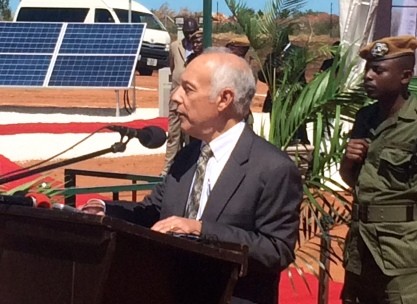
Your Excellency of the Republic of Zambia, President Edgar Chagwa Lungu
Honorable Secretary of the Cabinet
Honorable Members of Parliament
Distinguished Government Officials
Cooperating Partners
Representatives from the Power Sector
Friends in the Media
Ladies and Gentlemen
Thank you for the opportunity to provide a few remarks this morning at this very important event.
The United States Government has been pleased to intensify its efforts with the Government and people of Zambia to increase energy generation and access through clean, renewable energy. We believe the Industrial Development Corporation, or IDC/IFC Scaling Solar program offers an excellent example, and one we have been pleased to support under Power Africa.
U.S. President Obama announced the Power Africa initiative in 2013. While initially focused on 6 African countries, last year it expanded continent-wide, with the goals of increasing power capacity by 30,000 MWs and connecting 60 million new households and businesses to electricity by the year 2030.
Electricity is the lifeblood of any modern economy, and Zambia’s future economic prospects are closely tied to development of the energy sector. The load-shedding that the country has experienced for many months has already cost Zambia dearly in terms of productivity, jobs and development.
In Zambia, the United States has partnered with Sweden, the African Development Bank and the World Bank under Power Africa to support innovative approaches to increase renewable energy generation and access, including for the more than 70% of Zambians who currently have no electric power.
Harnessing solar power for electricity generation is one such approach. New technologies have been driving down sharply the costs of solar energy, and with over 300 days of sunshine per year, Zambia has great untapped potential.
Private sector investment is absolutely essential to realizing that potential, and the Zambian Government has a vital role to play in that regard by streamlining and reforming procurement processes, implementing cost-reflective tariffs, and reducing financing risks. There is still much work that needs to be done.
We therefore applaud the Zambian Government and the IFC for this innovative Scaling Solar venture. It has created a transparent, competitive bidding process to attract qualified solar power developers, and it will offer adequate prices, and streamlined procurement processes, to facilitate implementation of solar power production.
And we are pleased that we have been able to provide, through Power Africa and USAID/Zambia, $2 million in funding to support Zambia’s first round of Scaling Solar to help lower project development costs by covering the “success fees” payable by the IDC, to the IFC, once deals have reached financial close.
The United States remains committed to working with the Zambian government and people to achieve long-term power sector development that extends beyond the current power crisis and uplifts the standard of living of millions who have never had electricity before.
Thank you.







Comment
Make a general inquiry or suggest an improvement.